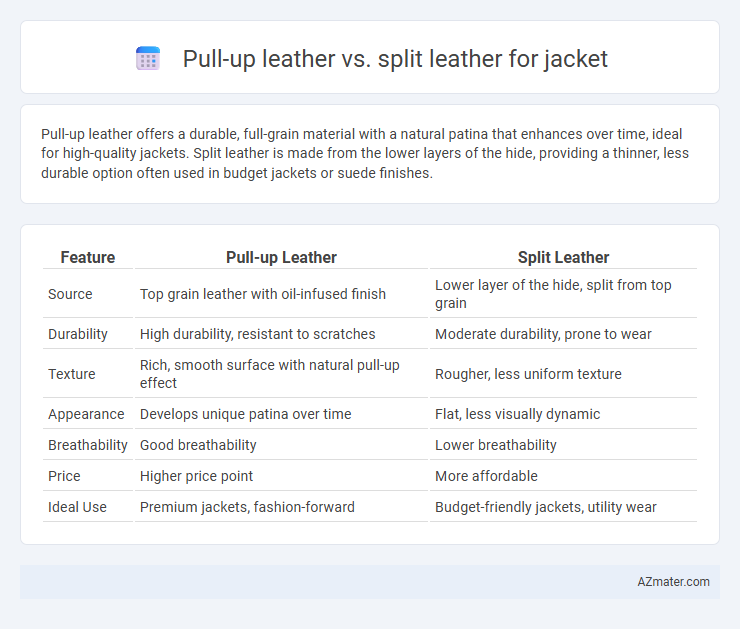Pull-up leather offers a durable, full-grain material with a natural patina that enhances over time, ideal for high-quality jackets. Split leather is made from the lower layers of the hide, providing a thinner, less durable option often used in budget jackets or suede finishes.
Table of Comparison
| Feature | Pull-up Leather | Split Leather |
|---|---|---|
| Source | Top grain leather with oil-infused finish | Lower layer of the hide, split from top grain |
| Durability | High durability, resistant to scratches | Moderate durability, prone to wear |
| Texture | Rich, smooth surface with natural pull-up effect | Rougher, less uniform texture |
| Appearance | Develops unique patina over time | Flat, less visually dynamic |
| Breathability | Good breathability | Lower breathability |
| Price | Higher price point | More affordable |
| Ideal Use | Premium jackets, fashion-forward | Budget-friendly jackets, utility wear |
Understanding Pull-up Leather
Pull-up leather is a type of full-grain leather treated with oils and waxes to create a distinctive distressed look when stretched or pulled, making it highly valued for jackets due to its durability and unique aging process. Unlike split leather, which is derived from the lower layers of the hide and coated to mimic full-grain appearance, pull-up leather retains the natural grain and strength, resulting in superior breathability and comfort. Its ability to develop a rich patina over time enhances the jacket's character, offering both aesthetic appeal and functional longevity.
Key Characteristics of Split Leather
Split leather is made from the fibrous part of the hide left after the top grain is separated, characterized by its rougher texture and lower durability compared to full-grain leathers like pull-up leather. It is often coated with a layer of pigment or polyurethane to enhance appearance and increase resistance to wear and water, but this treatment can limit breathability and natural aging. Split leather jackets tend to be more affordable while offering decent strength and flexibility, making them suitable for fashion-focused wear rather than heavy-duty use.
Visual Appeal: Pull-up vs Split Leather
Pull-up leather exhibits a rich, vibrant patina that deepens with wear, enhancing the jacket's visual appeal through natural color variations and a supple finish. Split leather tends to have a less uniform surface with a rougher texture, often lacking the smooth, polished look characteristic of pull-up leather. The dynamic aging process of pull-up leather creates a unique, vintage aesthetic that split leather typically cannot replicate.
Durability and Longevity Comparison
Pull-up leather, known for its top-grain quality and natural oils, offers superior durability and develops a unique patina over time, enhancing jacket longevity. Split leather, derived from the fibrous layer beneath top-grain, tends to be less durable and more prone to wear and tear due to its lower density and lack of natural oils. Investing in pull-up leather jackets ensures greater resistance to cracking and abrasion, making them ideal for long-term use compared to split leather options.
Comfort and Wearability Factors
Pull-up leather offers superior comfort due to its full-grain structure, which becomes softer and more pliable with use, conforming naturally to the body's shape. Split leather, derived from the lower layers of the hide, tends to be less breathable and stiffer, often requiring additional treatments to enhance comfort and flexibility. For jacket wearability, pull-up leather provides better durability and a luxurious feel, while split leather jackets may show wear more quickly and generally require more maintenance.
Maintenance and Care Requirements
Pull-up leather jackets require regular conditioning with leather oils or creams to maintain their distinctive aged patina and prevent drying or cracking, while split leather jackets need frequent cleaning and waterproofing to enhance durability due to their rougher texture. Avoid excessive exposure to moisture and direct sunlight for both types to prolong their lifespan and preserve appearance. Using a soft cloth for dust removal and storing jackets in breathable garment bags can significantly reduce wear and maintain flexibility.
Price Differences Explained
Pull-up leather jackets generally command higher prices due to their full-grain leather quality and durable, natural wax treatments that develop a unique patina over time. Split leather jackets, derived from the fibrous lower layers of the hide, tend to be more affordable but lack the premium texture and strength of pull-up leather. Price differences between these two types reflect the manufacturing process, longevity, and aesthetic qualities valued in pull-up leather, making it a costlier yet more durable choice for jacket enthusiasts.
Best Uses: Pull-up vs Split Leather Jackets
Pull-up leather, known for its waxy finish and natural stretch, is ideal for jackets requiring durability and a vintage, rugged appearance that improves with age. Split leather, derived from the fibrous part of the hide, suits budget-friendly jackets but lacks the strength and patina development of pull-up leather. For long-lasting, stylish outerwear, pull-up leather jackets outperform split leather options, especially in heavy-use or fashion-focused scenarios.
Pros and Cons of Each Leather Type
Pull-up leather offers rich, natural aging and develops an attractive patina over time, making it highly durable and resistant to water, ideal for premium jackets seeking a vintage look. Split leather is more affordable and lighter, but it lacks the strength and elasticity of full-grain pull-up leather, leading to quicker wear and less water resistance. While pull-up leather provides superior longevity and aesthetic appeal, split leather suits budget-conscious buyers prioritizing lightweight and flexibility over durability.
Which Leather is Right for Your Next Jacket?
Pull-up leather offers a rich, vintage look due to its wax-treated surface that darkens and lightens with wear, making it ideal for those seeking a distressed, rugged style. Split leather, derived from the lower layers of the hide, tends to be less durable but more affordable, often used in budget-friendly jackets with a suede-like texture. Choosing between pull-up and split leather depends on whether you prioritize durability and patina development or cost-effectiveness and a softer feel for your next jacket.

Infographic: Pull-up leather vs Split leather for Jacket
 azmater.com
azmater.com